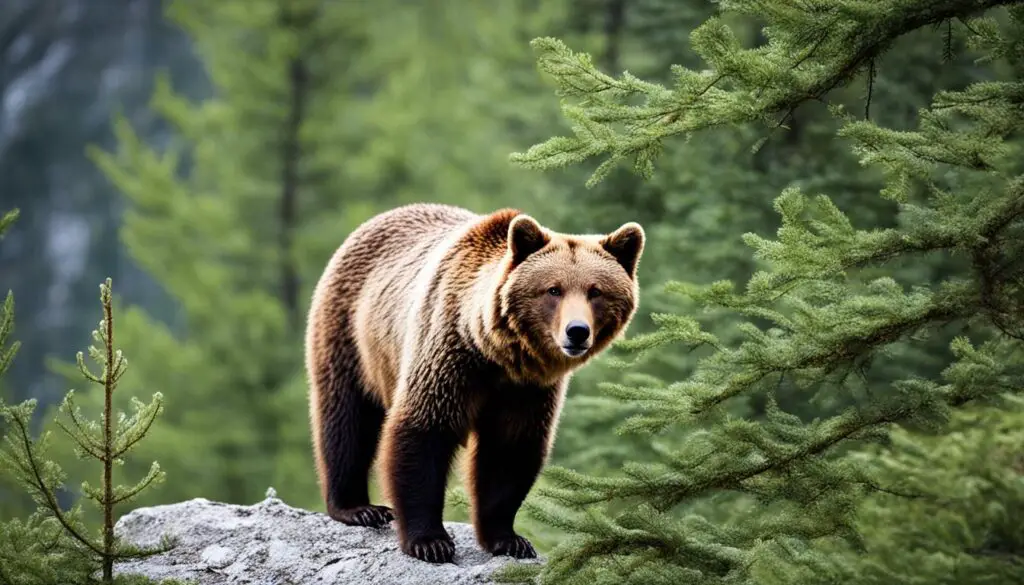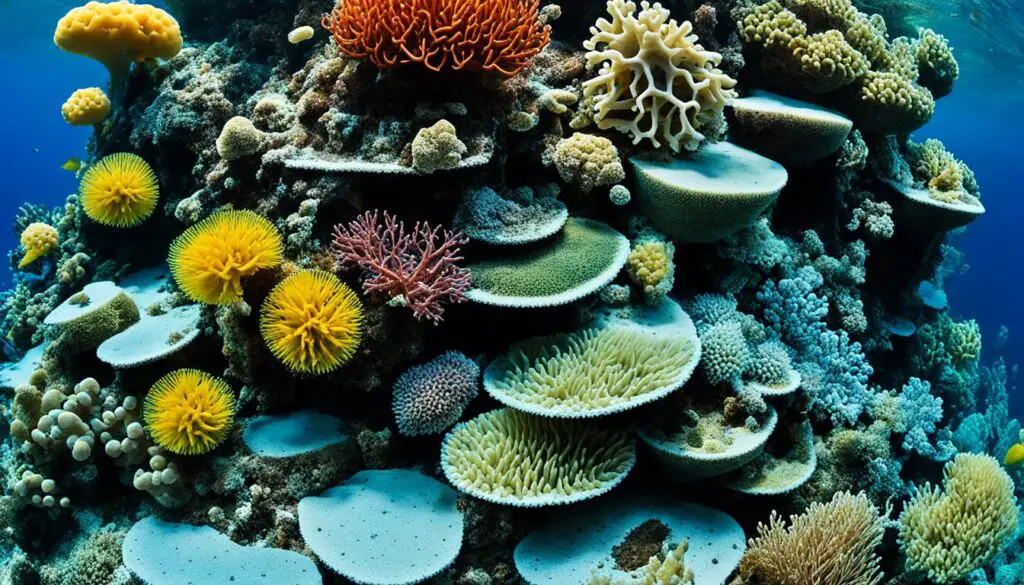Did you know that over 22,500 species of wildlife have been recorded in North Macedonia? This small Balkan nation is home to a remarkably rich and diverse array of animals, making it a paradise for wildlife enthusiasts and nature lovers. From magnificent mammals to fascinating birds, the country’s biodiversity is truly awe-inspiring.

Key Takeaways:
- North Macedonia is home to over 22,500 species of wildlife.
- The country boasts over 300 species of birds, 80 species of mammals, and 80 species of fish.
- The diverse landscape, including mountains, rivers, and lakes, contributes to North Macedonia’s rich biodiversity.
- Human activities, such as hunting, land use change, pollution, and climate change, pose threats to wildlife in the country.
- Conservation efforts are essential to safeguard the unique and valuable biodiversity of North Macedonia.
Flora of North Macedonia
North Macedonia is home to a wide variety of plant species, with over 3,700 vascular plants identified. The country’s diverse flora showcases its rich biodiversity and unique ecological characteristics. In this section, we will explore the fascinating world of plants in North Macedonia, including endemic species, forest coverage, and the conservation of endangered plants.
Endemic and Near-Endemic Plants
North Macedonia is known for its remarkable collection of endemic and near-endemic plant species. Among the 3,700 identified vascular plants, 116 species are found exclusively or predominantly within the country’s borders. These plants have adapted to the specific climatic and environmental conditions of North Macedonia, making them uniquely significant to the region’s biodiversity.
Forest Coverage
The forests of North Macedonia play a vital role in maintaining the country’s ecological balance. Forested areas cover a significant portion of the land, with deciduous forests being the most common type. These forests are home to a diverse range of plant species, providing habitat and resources for various animal species as well.
In recent years, the forested land has experienced a slight expansion, which is encouraging for the preservation of the country’s biodiversity. However, there are concerns about the decreasing coverage of coniferous and mixed forests, highlighting the need for sustainable forest management practices.
Conservation of Endangered Plant Species
Despite the lush flora in North Macedonia, some plant species face the risk of extinction. The loss of habitat, climate change, and other human activities pose significant threats to these endangered plants. Conservation efforts are necessary to ensure their survival for future generations to appreciate and study.
Scientists and conservationists in North Macedonia are working tirelessly to protect and conserve the endangered plant species. Efforts include habitat restoration, seed banks, and the creation of protected areas for these plants to thrive.
Diverse Range of Fungi
In addition to vascular plants, North Macedonia is also home to a diverse range of fungi. With over 2,000 identified species, including 450 lichens, the country’s fungi contribute to the overall richness of its flora. These fungi play essential ecological roles, from decomposition to forming symbiotic relationships with other organisms.
Exploring the flora of North Macedonia provides invaluable insights into the country’s unique ecological heritage. By understanding the plant species, their habitats, and the efforts undertaken for their conservation, we can contribute to the preservation of North Macedonia’s remarkable biodiversity.
Invertebrates of North Macedonia
North Macedonia is a haven for invertebrate enthusiasts, boasting a diverse range of species. With over 13,000 recorded invertebrates, the country offers a wealth of natural wonders to discover. Arthropods dominate the invertebrate population, comprising an impressive 90% of all species found in North Macedonia. These include a wide variety of arthropod species, including arthropod species Macedonia.
The three major lakes in the country, Lake Ohrid, Lake Prespa, and Lake Dojran, are not only home to unique fish species but also host several sponge species. Some of these sponges are endemic to North Macedonia, making their presence even more remarkable. The sponge species found in North Macedonia make for intriguing subjects of study, highlighting the country’s diverse aquatic ecosystems and the importance of their conservation.
North Macedonia also boasts a rich diversity of fungi, with over 2,000 identified species. These fungi play critical ecological roles, contributing to nutrient cycling and supporting the overall health of ecosystems. However, it is important to note that certain fungal species in North Macedonia face threats and are considered threatened fungi North Macedonia. Conserving these fungi is crucial to preserving the delicate balance of the country’s ecological systems and protecting their biodiversity.
| Invertebrate Group | Number of Species |
|---|---|
| Arthropods | Over 11,700 species |
| Sponges | Multiple species |
| Fungi | Over 2,000 species |

Exploring the invertebrates of North Macedonia provides valuable insights into the country’s unique ecosystems and their intricate interconnectedness. It is essential to recognize the importance of conserving these invertebrate species, both for their intrinsic value and for the overall health of the environment. By safeguarding the habitats of these invertebrates and raising awareness about their ecological significance, North Macedonia can continue to be a sanctuary for these remarkable creatures.
Fauna of North Macedonia
North Macedonia is rich in fauna, boasting a diverse range of mammal, bird, and fish species. The country’s complex zoogeographic structure contributes to its abundant wildlife.
Mammals
The forests of North Macedonia provide habitat for a variety of mammal species. Some of the notable mammals found in the country include bears, wolves, wild boars, and lynx. The lynx, in particular, holds a significant status as a national animal of North Macedonia.
Birds
The diverse landscapes of North Macedonia, including forests, lakes, and mountains, attract a wide range of bird species. Some of the bird species commonly found in the country include the blackcap, grouse, imperial eagle, and forest owl. Birdwatchers can enjoy observing these fascinating creatures in their natural habitats.
Lakes and Fish Species
The lakes of North Macedonia support a rich variety of fish species. Gudgeon, trout, and whitefish are among the fish species that can be found in the country’s lakes. These lakes provide important habitats for aquatic life and contribute to the overall biodiversity of North Macedonia.

With its diverse fauna, North Macedonia offers ample opportunities for wildlife enthusiasts to explore and appreciate the natural wonders of the region. The preservation of these species and their habitats is essential for the long-term sustainability of North Macedonia’s unique biodiversity.
Conclusion
North Macedonia is home to a rich and diverse array of wildlife, with over 22,500 recorded species. This high level of biodiversity is a testament to the country’s unique natural heritage. However, human activities such as hunting, land use change, pollution, and climate change pose significant threats to the survival of these species.
In response to these challenges, North Macedonia has implemented various conservation efforts to protect and preserve its wildlife. The establishment of national parks and the implementation of action plans have been crucial in safeguarding endangered species and promoting biodiversity conservation.
It is imperative that these efforts continue and are strengthened to ensure the long-term survival of North Macedonia’s wildlife. By prioritizing endangered species protection and implementing effective conservation measures, the country can preserve its invaluable natural treasures for future generations to enjoy.
